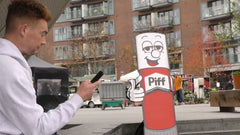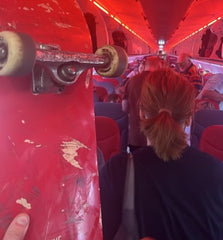contact@tuesdaysskateshop.co.uk
Fast Free Delivery on orders £40.00 and over

- Apr, 21 , 21
- 2 comments
Fair Avoidance | The Bust Station Zine
One of Britain's most controversial and iconic brutalist buildings is Preston Bus Station. Built in 1969, Preston Bus Station has stood the test of time, fighting off demolition plans and corporate regeneration projects left, right and centre through the ‘Save Preston Bus Station’ campaign, organised initially by John Wilson.
Preston Bus Station is one of the few remaining 1960’s brutalist buildings in the UK and is listed along with Southbank on the World Monument Watchlist. The value of Preston Bus Station, much like Southbank, comes not only from the iconic concrete brutal aesthetic, but also for what it represents. In the hope of linking post-war Britain together, Preston, was subject to a number of influential ‘firsts’ for the UK, such as the first stretch of motorway in the country, 2 miles from Preston Bus Station at Broughton Interchange built in 1958. And Preston railway station which had been a major half-way stopping point between Glasgow and London and Preston Bus Station, at the time the world’s largest bus station. Apart from its iconic design, similarly to Southbank, the bus station became a hive for activity in the mid 1980’s with skateboarders populating the attached multi-storey carpark.

In 2000, the Tithebarn project was proposed and finalised in 2005 in conjunction with the Lend Lease Corporation (LLC) from Sydney and Preston City Council. This is a prime example of international capital and its influence on public space, as can be seen with the Peel Group in Manchester. Although the planning applications had been approved, against general public consensus. In 2011 the proposed redevelopments which would have featured a huge regeneration of public land and ownership transference to the Sydney based LLC, was abandoned. This was due to a number of factors, including public objection and major investors questioning the validity of the scheme financially. In place of this regeneration and restoration plan, Preston City Council decided to seek plans to demolish the famous and architecturally revered bus station.
In September 2013, it was announced that the ‘Save Preston Bus Station’ campaign had also been successful in gaining listing status and that this was deemed to be a site of significant cultural heritage for both Britain and the local community as a whole and was therefore granted by English Heritage. John Puttnick associates worked at reconstituting Preston Bus Station in a regeneration scheme which would allow the building to keep its primary functions and historical value, whilst adding a ‘free open social space’ for the people of Preston. The idea was to incorporate cultural aspects of the bus station’s history with a new multifunctional free-space which would also feature a youth centre and art facilities.

The designs were sent out to the local community, with lead architects coming to speak to skateboarder’s through the local university - this was to give them an idea of how the space would function and have their input in design. Arguably, this was a huge step in the cohesion of public planning and the public who will use these spaces. Most of which, included skateboarders and skateboarding within the architectural mock-up. We were stoked to say the least. This was another way in which you can see skateboarding permeate into popular culture and be taken seriously as a form of expression and history within the city, showing the impact that 30 years of skateboarding at one of the most controversial brutalist buildings in the UK had for the wider community.

From the architectural mock-ups presented by John Puttnick and associates skateboarders are present within the design, not only are they a feature of the design but the space suggests that they are actively included in the ultimate plan for the new reimagined bus station. However, as quickly as skateboarding was included and celebrated both in the redesign of the bus station and the English Heritage funded exhibit, the regeneration plans were revised. “In their minds, there was no place for skateboarders or skateboarding, we had done our job, we had been celebrated, now we were to be excluded from the space.” The redesign of the regeneration plan, was due to a funding disagreement with the youth charity that was to build the youth centre at the bus station. Lancashire County Council refused to contribute funding to the building of the youth centre which had been agreed by Preston City Council and proposed the youth charity was to build the centre to the tune of £10,000,000, but could only deal with the management of it for 10 years. After 10 years the control would be given to Lancashire County Council. This political argument tore down the plans for the youth centre, which was replaced by smooth open social space across the front of the bus station.
The space had no purpose. It had initially been there to house buses, but in the regeneration plans, it was made into an extremely large area for public access. Within this area, most aspects of the dual functional space had been maintained, for example skate friendly objects, like ledges, banks and smooth granite flat ground - the only thing that changed was the politics behind the spaces use.

This zine features a collection of analogue video stills taken from the Sony VX throughout the filming of a full length video titled: Fair Avoidance. Fair Avoidance hopes to critique the way in which we use public space and highlights the way in which not only skateboarder's use space, but how multifunctional spaces can positively encourage cohesion between people within the city.
Concretecreeps is a photographer & visual artist from Preston, Lancashire compiling variant examples of post war, raw concrete and brutalist architecture through photography and film. Big thank you for all his content and contributions to the zine, it was a pleasure to work alongside you and we can't wait to do more projects like this.
You can pick yours up for £6 (£8 posted) via DM to The Bust Station by clicking here. Or fire the money straight to our PayPal here <<
All proceeds from the zine will be donated to Live Like Ralph
Live Like Ralph is a charitable organisation set up in honour of Ralph Roberts, who sadly passed away on the 3rd of January 2021.
Ralph, amongst many other things, was a keen skater and creative. It is our mission to help support and maintain both of those communities so that they can continue to grow. We believe, as Ralph did, that by nurturing these communities, and all of the potential talent that lies within them, the positive impact they can have is extraordinary.
Search
Recent Post
Archive
- February 2025
- November 2024
- December 2023
- October 2023
- September 2023
-
- Dime MTL X Vans Geoff Rowley XLT Shoe release and insight
- Andrew Reynolds NM480 Shoe remix for New Balance Numeric - Out now
- Helas Fall 2023 Collection Preview, Look book & Size guides.
- Coffee Shop Then Paral-lel? | Charlie Arlett and the Ledge Lords in BCN
- Anti Hero UK Tour | DLH Takeover | Full Video Recap
- April 2023
Tags
- "I'd Rather watch Gino push"
- "Nothing Meaner" Dean Lane Skatepark | Bristol
- #QSTOP10 - 2018 Quartersnacks
- #ShuvitCancer - Elaine Shallcross
- #TONYHAWKWEEK Tony Hawk Battle Commander
- 'A Christmas Collective' - Jake Powell // ATB Collective
- 'B TEAM VIDEO' from Classic Grip
- 'Boltonia' Vol.2
- 'Celito Bango' by Jake Powell
- 'CUB 3000'




2 comments
Janet Lythgoe
Apr 21, 2021 at 19:39Very interesting and informative piece. Well worth the read.
Liffy
Apr 21, 2021 at 19:13Really really good write up!